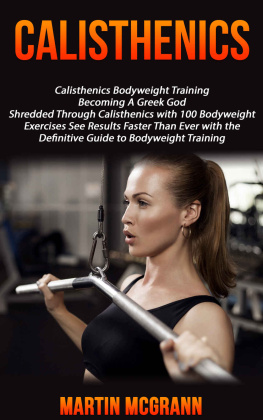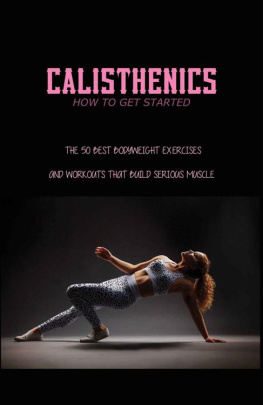Copyright 2017
Pure Calisthenics
All rights reserved. No part of this publication may be reproduced, distributed, or transmitted in any form or by any means, including photocopying, recording, or other electronic or mechanical methods, without the prior written permission and consent of the publisher, except in the case of brief quotations embodied in product reviews and certain other non-commercial uses permitted by copyright law.
Disclaimer:
This guide has been created for informational and reference purposes only. The author, publisher and other affiliated parties cannot be held in any way accountable for any personal injuries or damage allegedly resulting from the information contained herein, or from any misuse of such guidance. Although strict measures have been taken to provide accurate information, the parties involved with the creation and publication of this guide take no responsibility for any issues that may arise from alleged discrepancies contained herein. It is strongly recommended that you consult a physician, personal trainer and nutritionist prior to commencing this or any other workout or diet plan. This guide is not a substitute for professional personal guidance from a qualified medical professional. If you feel pain or discomfort at any point during the exercises contained herein, cease the activity immediately and seek medical guidance. This resource has been created to teach stretching in a progressive manner, and you should not advance until you have completed the simpler stretches as recommended with perfect form. It is strongly recommended that you use a spotter or personal trainer at all times.
calisthenics
[kal- uh s- then -iks]
Noun
1. Gymnastic exercises designed to develop physical strength, vigor and grace of movement, usually performed with little or no special apparatus.
Origin
Greek kallos beauty + sthenos strength + -ics.
Before you Begin:
Free Bonus Stretching Guide
Stretching wrong can be costly in more ways than one. At best you may simply fail to make any progress towards your flexibility goals, and at worst you may do serious damage to your muscles, ligaments or tendons. Not on our watch!
To avoid injury and help accelerate your progress, pick up our free Top 10 Stretching Mistakes guide to make sure YOU arent falling into these common traps.
You'll find yours at the back of this book. Can't wait?
>><<
Table of Contents
Introduction
You have a hidden weakness, a chink in your armor, holding you back from achieving your full potential in calisthenics and bodyweight exercise.
You cant quite hold a certain position; perfect form often evades you and those last few reps are tantalizingly out of reach. You know your body is capable of more, but you just cant level up and as a result your progress plateaus.
Just how the hell do all these YouTube superstars manage to make it all look so damn easy? Well, amigos, they have a secret weapon, and its name is range of motion.
Range of motion is defined as the positions at which you start, move through and finish any particular exercise. Tight muscles = shorter range of motion = less strength.
With greater flexibility, therefore, comes greater range of motion, and with it superior strength building ability. This cycle repeats all the way to SUPERHUMAN!
The bad news is youve probably been stretching wrong all your life. Seriously, even if you are absolutely, positively certain that you know it all, were willing to bet youre missing something. The good news is, the secret formula is right here in your hands.
Using five simple scientific techniques you will see immediate improvements in both your flexibility and ROM. This, in turn, will allow you to compound your strength and muscle gains at unprecedented rates.
Join us as we dive into the latest installment in The SUPERHUMAN Series and get set to experience mind-blowing results.
1. Flexibility in a Nutshell
Stretching Does not Guarantee Flexibility
Youre going to have to get used to the fact that much of what you have been told to date is untrue. So, this eye-opener seems a good place to start.
Of course, stretching is a prerequisite for flexibility, but it is only one piece of the puzzle, and while you can make progress through exercises alone, you may find it a slow and frustrating process. But dont worry, youre not alone!
Its a commonly held misconception throughout the fitness community that in order to achieve your desired level of flexibility a rigorous regime of stretching is required to increase elasticity and prevent your muscles from shortening and tightening over time.
Were here to show you a much faster and more sustainable route to success, and were guaran-damn-teeing results!
The Science
When you complete a strenuous exercise, very tiny tears appear in your target muscles. This is due to the intense physical trauma they were just put through, and when they heal they generally increase in both size and performance. However, when the muscle healing process is taking place, a small amount of scar tissue is formed, which has the effect of pulling the muscle fibers together, effectively making it shorter or tighter.
Whats more, with age comes degradation of the connective tissues throughout your body. As you get older, your elastin levels slowly decrease. These elastin proteins are the components in your ligaments and tendons that allow them to deform and return to their original shape, or flex. As your elastin levels drop, so does the range of motion that these connective tissues can tolerate.
So how is it that we sometimes come across folks well into their 60s and 70s who are still as supple as a wet noodle?
It is here that some coaches might step in and say that strenuous and perhaps painful stretching is required to counteract the muscle-shortening effect, but if grandmothers and grandfathers across the globe can maintain their flexibility then surely there must be an easier way! To get there we need to think smarter, not harder.
Its all in Your Head
Or, more precisely, your nervous system. Day-to-day we keep our bodies in the same general envelope of movement. We sit in the same posture, walk around with the same motion, and relax in the same pose. This repetitive use of our body creates what can be thought of as the blueprint of how our muscles generally move, and our brain follows that blueprint to the letter.
Make no mistake; your brain is one crotchety, retentive piece of work. No matter how much you may try to force the issue, it will always automatically resist moving your muscles out of its predetermined comfort zone.
To see this in practice for yourself, try this well-known little drill:
Take one leg and lift it to the side at 90 degrees, placing it on a chair or table. Pretty easy isnt it? OK, next step.
Now lower that leg and repeat with the other. That feels pretty easy too, huh? Lets ramp it up a notch.
Prepare to do the splits. Whats that? What do you mean you cant?! Youve just had each leg at a 90-degree angle individually, so whats stopping you doing both at the same time?
Believe it or not, there are no physical barriers to you completing this exercise. Zip, zilch, nada, and zero.
What youre experiencing is your bodys automatic control system taking over. It allows you to move your legs to 90 degrees individually, but when you try to do both at the same time - something completely alien to most people - everything gets locked down.









